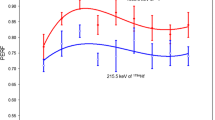Abstract
As a non-destructive and multi-element technique, with high-level metrological properties, instrumental neutron activation analysis (INAA) has an important role to determine chemical elements in food. However, its use may be limited when looking for mass fractions near the detection limits. The Compton scattering of higher energy gamma-rays raised the spectrum baseline thus impairing the determination of several elements. Therefore, the gamma-ray spectrometry with Compton suppression becomes an alternative for improving the performance of INAA, since it can reduce the uncertainty of measurements and the detection limits by increasing the proportion between photopeak area and baseline. Here the performance of a Compton suppression system set by Ortec, with 50% relative efficiency and 2.04 keV resolution (FWHM) for the 1,332 keV photopeak, was evaluated for food analysis. Samples of beans, chickpeas, lentils, peas, and rice were irradiated with neutrons and measured in the suppression system. Detection limits calculated from suppressed and unsuppressed spectra were compared. The suppression factor achieved by the system for 137Cs was 5.88 ± 0.11 (n = 20) in the plateau region (358 to 382 keV), which was stable along a 20 week period and similar to the data provided in literature for other systems. Amongst fifteen elements determined, the detection limits for Br, Co, La, Na, Sc, and Se were not improved by the use of Compton suppression. On the other hand, the variable improvement obtained for As, Ca, Cd, Cr, Fe, Hg, K, Rb, and Zn corroborated the idea that the performance of the Compton suppressor must be individually assessed for each type of sample.


Similar content being viewed by others
References
Lehninger AL (1990) Princípios de bioquímica, Sarvier Editora de Livros Médicos Ltda, São Paulo
Senesi GS, Baldassarre G, Sensi N, Radina B (1999) Chemosphere. doi:10.1016/S0045-6535(99)00115-0
Iyengar GV, Nair PP (2000) Sci Total Environ 249(1–3):331–46. doi:10.1016/S0048-9697(99)00529-X
Greenberg RR, Bode P, Fernandes EAN (2011) Spectrochim Acta B. doi:10.1016/j.sab.2010.12.011
American National Standards Institute (ANSI). (1986) IEEE standard test procedures for germanium gamma-ray detectors, New York
França EJ, Fernandes EAN, Bacchi MA (2003) J Radioan Nucl Chem. doi:10.1023/A:1024705628697
Bacchi MA, Santos LGC, Fernandes EAN, Bode P, Tagliaferro FS, França EJ (2007) J Radioan Nucl Chem. doi:10.1007/s10967-007-0215-0
Bacchi MA, Fernandes EAN, Oliveira H (2000) J Radioan Nucl Chem. doi:10.1023/A:1006766923721
Bacchi MA, Fernandes EAN, França EJ (2000) J Radioan Nucl Chem. doi:10.1023/A:1006719902407
Bacchi MA, Fernandes EAN (2003) J Radioan Nucl Chem. doi:10.1023/A:1025496716711
Parus J, Kierzek J, Raab W, Donohue D (2003) J Radioan Nucl Chem. doi:10.1023/A:1026270428392
Hien DS (1996) Nucl Instrum Methods. doi:10.1016/0168-9002(95)01437-3
Carpenter MP, Khoo TL, Ahmad I, Janssens RVF, Lauritsen T, Annan GA, Baxter AM, Bleich ME, Harfenist S, Moore EF, Torelli M, Visser DW (1994) Nucl Instrum Methods. doi:10.1016/0168-9002(94)91645-4
Landsberger S (1994) J Radioan Nucl Chem. doi:10.1007/BF02037926
Mauerhofer E, Tharun U, Denschlag HO, Schmidt R, Kratz JV (1996) Nucl Instrum Methods. doi:10.1016/0168-9002(95)01009-2
Voigt MJA, Bacelar JC, Micek SL, Schotanus P, Verhoef BAW, Wintraecken YJE, Vermeulen P (1995) Nucl Instrum Methods. doi:10.1016/0168-9002(94)01204-0
Fukuda K, Ohkuma J, Asano T, Satoh Y (1996) Nucl Instrum Methods. doi:10.1016/0168-583X(96)00206-6
Westphal GP, Jöstl K, Schröder P, Lauster R, Hausch E (1999) Nucl Instrum Methods. doi:10.1016/S0168-9002(98)00981-4
Harbottle G, Cumming JB (1994) Nucl Instrum Methods. doi:10.1016/0168-9002(94)91709-4
Satoh Y, Fukuda K, Ohkuma J, Asano T, Taniguchi R, Fujishiro M (1995) Appl Radiat Isot. doi:10.1016/0969-8043(95)00196-K
Acknowledgment
The authors are thankful to Fundação de Amparo à Pesquisa do Estado de São Paulo (FAPESP) and Coordenação de Aperfeiçoamento de Pessoal de Nível Superior (CAPES) for the financial support, and Instituto de Pesquisas Energéticas e Nucleares, Comissão Nacional de Energia Nuclear (IPEN/CNEN) for the irradiation of samples with neutrons.
Author information
Authors and Affiliations
Corresponding author
Rights and permissions
About this article
Cite this article
dos Santos, L.G.C., Bacchi, M.A., De Nadai Fernandes, E.A. et al. Performance of Compton suppression system (CSS) and applicability in food matrices. J Radioanal Nucl Chem 291, 179–185 (2012). https://doi.org/10.1007/s10967-011-1286-5
Received:
Published:
Issue Date:
DOI: https://doi.org/10.1007/s10967-011-1286-5




